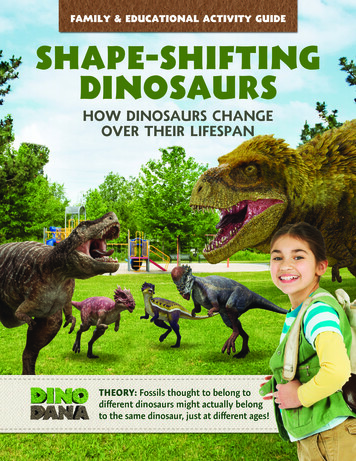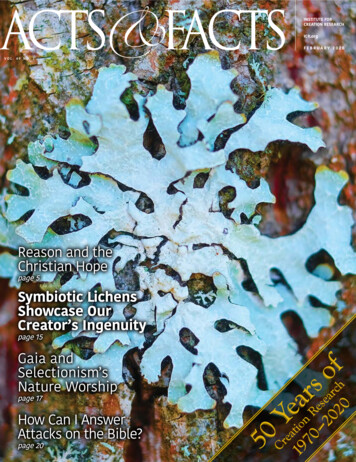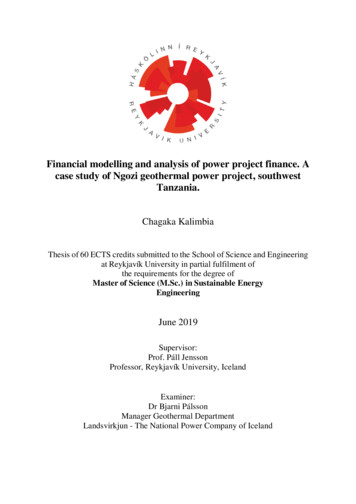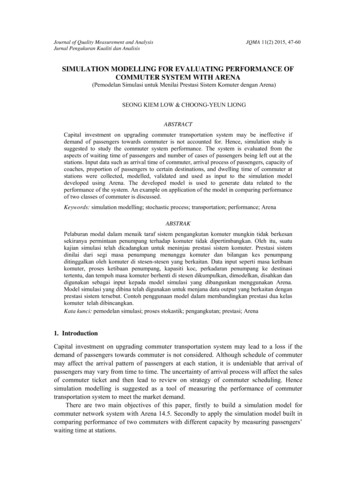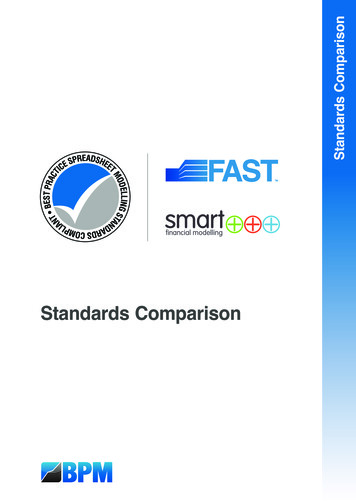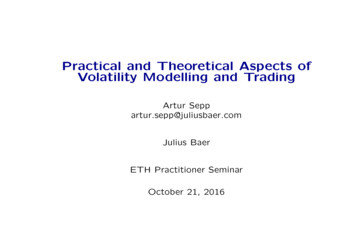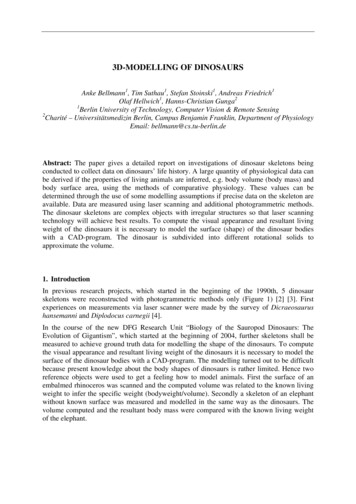
Transcription
3D-MODELLING OF DINOSAURSAnke Bellmann1, Tim Suthau1, Stefan Stoinski1, Andreas Friedrich1Olaf Hellwich1, Hanns-Christian Gunga21Berlin University of Technology, Computer Vision & Remote Sensing2Charité – Universitätsmedizin Berlin, Campus Benjamin Franklin, Department of PhysiologyEmail: bellmann@cs.tu-berlin.deAbstract: The paper gives a detailed report on investigations of dinosaur skeletons beingconducted to collect data on dinosaurs’ life history. A large quantity of physiological data canbe derived if the properties of living animals are inferred, e.g. body volume (body mass) andbody surface area, using the methods of comparative physiology. These values can bedetermined through the use of some modelling assumptions if precise data on the skeleton areavailable. Data are measured using laser scanning and additional photogrammetric methods.The dinosaur skeletons are complex objects with irregular structures so that laser scanningtechnology will achieve best results. To compute the visual appearance and resultant livingweight of the dinosaurs it is necessary to model the surface (shape) of the dinosaur bodieswith a CAD-program. The dinosaur is subdivided into different rotational solids toapproximate the volume.1. IntroductionIn previous research projects, which started in the beginning of the 1990th, 5 dinosaurskeletons were reconstructed with photogrammetric methods only (Figure 1) [2] [3]. Firstexperiences on measurements via laser scanner were made by the survey of Dicraeosaurushansemanni and Diplodocus carnegii [4].In the course of the new DFG Research Unit “Biology of the Sauropod Dinosaurs: TheEvolution of Gigantism”, which started at the beginning of 2004, further skeletons shall bemeasured to achieve ground truth data for modelling the shape of the dinosaurs. To computethe visual appearance and resultant living weight of the dinosaurs it is necessary to model thesurface of the dinosaur bodies with a CAD-program. The modelling turned out to be difficultbecause present knowledge about the body shapes of dinosaurs is rather limited. Hence tworeference objects were used to get a feeling how to model animals. First the surface of anembalmed rhinoceros was scanned and the computed volume was related to the known livingweight to infer the specific weight (bodyweight/volume). Secondly a skeleton of an elephantwithout known surface was measured and modelled in the same way as the dinosaurs. Thevolume computed and the resultant body mass were compared with the known living weightof the elephant.
Figure 1: Dinosaurs measured with photogrammetric methods (same scale): Brachiosaurus(top left), Diplodocus (bottom left), Dicraeosaurus (top right), Iguanodon (right of centre),Allosaurus (bottom right)2. Methodology of Data RecordingCalibrated distanceDinosaur skeletons are complex objects with irregular structures so that laser scanningtechnology will achieve best results to determine the shape of the bones. Due to the size of theskeletons (about 20 m length and 12 m height) the short range laser scanner, S25 fromMENSI (Figure 2) was chosen for the measurements. The accuracy orthogonal to range for ameasurement distance of 4 m is about 0.8 mm vertical and 0.2 mm horizontal. The accuracydecreases due to the triangulation principle of the scanner to 3.8 mm vertical and 3.4 mmhorizontal at 10 m range. The distance accuracy is about 0.2 mm at 4 m and 1.4 mm at 10 mrange [1].LaserObjectReference SpheresCCD-SensorScanner Mensi S25Figure 2: Laser Scanner Mensi S25, triangulation principleMeasurements show, that the registration accuracy for complete objects (25 m²) measuredwith ranges up to 24 m is less than 1,3 cm. Due to the fact, that modelling of the surfacecannot reach this accuracy, the achieved accuracy is sufficient for practical purposes.
Figure 3: Scanner setup with dinosaur skeleton and reference pointsTo acquire complete point clouds from the skeletons several scanner positions and referencepoints for registration were used (Figure 3). Additionally, photogrammetric images weretaken with the high-resolution digital camera Canon EOS 1D Mark II. They were used totexture the surface defined by the laser scanner point cloud.3. Data Recording3.1. Reference ObjectsBefore physiological parameters can be estimated on the basis of the dinosaur skeletons, it isnecessary to analyze additional data from living animals allowing to infer those parameters.Hence two reference objects were used to verify the modelling procedure. First the surface ofan embalmed rhinoceros was scanned. Secondly a skeleton of an elephant without knownsurface was measured.Figure 4: Embalmed rhinoceros Lipsi (left), Scanned 3D point cloud of Lipsi (right)The embalmed rhinoceros Lipsi of Naturkundemuseum Dresden was scanned in May 2004.Two days, 16 scanner setups and 15 reference points were needed to record the surface of
Lipsi nearly completely (Figure 4). The result is 700,000 scanned points with registrationaccuracy less than 3 mm.Figure 5: Juvenile Indian elephant skeleton; 3D point cloud of the skeletonThe skeleton of the Indian elephant of Zoological Museum of Copenhagen was measured inAugust 2004. The juvenile skeleton is of a size of 1.70 x 1.50 x 0.70 m³ and was scannedfrom 7 scanner positions in two days with 15 reference points used. Over 920.000 points ofthe acquired point cloud are located on the bones (Figure 5). The registration accuracy isbetter than 1 mm.3.2. Use of the Reference ObjectsTo compute the visual appearance and resultant living weight of the dinosaurs it is necessaryto get some information about the relation of body volume and living weight. Due to the factthat it is not possible to obtain those data from dinosaurs, other animals have to be used.Therefore, the surface of an embalmed rhinoceros was scanned and the computed volume wasrelated to the known living weight to infer the specific weight (bodyweight/volume). Thespecific weight of Lipsi amounts 1,15 kg/dm³. This is the result of the living weight, which is1050 kg, and the computed volume of the scanned surface, which is 914 dm³.To get a training and reference object for modelling animals, the skeleton of the Indianelephant without known surface was measured and modelled in the same way as thedinosaurs’ skeletons. The volume computed and the resultant weight were compared with theknown living weight of the elephant.3.3. Scanned Dinosaur SkeletonsFor determination of physiological data, several dinosaur skeletons are to be scanned withinthe scope of the research project. It is planned to acquire the data from the different livingperiods of the dinosaurs. Up to now five skeletons were scanned and analysed (Figure 6). InJuly 2004, the skeleton of Plateosaurus engelhardti was surveyed at the University ofTübingen. It is of a size of 4.30 x 0.80 x 1.90 m³ and was scanned from 10 scanner positionswith 17 reference points. The Atlassaurus imelakei was measured in November 2004 in Rabatand has a size of 10.00 x 1.90 x 4.50 m³. More than 1.1 million points were scanned from 16scanner positions. To register the scanner setups 23 reference points were used.
1mFigure 6: Scanned dinosaur skeleton: Atlassaurus (top left), Stegosaurus (top right),Plateosaurus (right of center), Camarasaurus (bottom left), Allosaurus (bottom right)In April 2005 three additional skeletons were scanned in Switzerland. Camarasaurus andAllosaurus were scanned from only one scanner position and without reference spheres as theskeletons were mounted on a wall. Nevertheless, it is possible to derive some 3D-data of thebones. The Stegosaurus was scanned from two scanner positions but also without referencepoints. The point clouds had to be registered point wise, which is less accurate and moredifficult to manage.Finally, some dinosaur skeletons were scanned in China (Beijing and Zigong) in May 2005which are still to be analysed. Among them were the Mamenchisaurus jingyanensis in Beijingand the Omeisaurus tianfuensis in Zigong, just to mention the most important ones.4. ModellingPresent models of dinosaurs are based on photogrammetric reconstructions of the skeletonswhich were printed and used by physiologists as scaled masters for drawing the shape of thedinosaur. The reconstructed shapes were subdivided into geometrical primitives likecylinders, frustums and spherical horns to compute the surface as well as the volume. Basedon these calculations, further physiological data could be derived [2].4.1. CAD Based CalculationTo improve the modelling of the surface rotational solids instead of geometric primitives wereapplied. The basis for CAD based modelling are the scanned and cleared point clouds of thedinosaur skeletons. According to physiological knowledge the dinosaur is subdivided intoconstructive rotational solids. These solids ensure an enhanced accommodation to
approximate the real shapes, also allowing complex changes of models with reasonable effort.Several rotational solids were diluted and the volume was computed accordingly (Figure 7).Figure 7: Modelling of the Indian elephant; left: CAD based determination of rotationalsolids; right: Modelling resultShape and volume of the modelled elephant were used to improve the approach to calculatethe assumed living weight of animals. Figure 7 (right) shows the modelling result of theelephant with a computed volume of 622 dm³. Adopting the specific weight of 1,15 kg/dm³,which was calculated from the rhinoceros (see section 3.2), a body weight of 715 kg is theresult. For comparison, the living weight known to the Zoological Museum of Copenhagen isabout 850 kg. The deviation which includes the modelling error of the computer modellingamounts to 16 % which seems to be a reasonable margin of deviation for the weight ofmammals.4.2. Modelling Using Fourier DescriptorsTo improve the modeling of the surface, instead of rotational solids user-defined surfaces areapplied resulting in an increased accuracy. First, the point cloud of the dinosaur skeleton iscut into defined vertical slices. It is then possible to draw a surface free-handedly around theslice. The silhouette of a digitised shape is given by the coordinates ( ( xk , yk ) , 0 k NU ),where NU is the number of pixels of the silhouette. The x-y coordinates of each point in thecontour to be analysed become complex numbers x one dimensional vector U 1 y. The contour is now given by the x 1 y 00 U # xNU 1 1y NU 1 (1)U k xk 1 yk , 0 k NU(2)or
The shapes of the user defined slices can be described by Fourier descriptors (Figure 8). TheFourier descriptor F μ of the silhouette U n is given byF μ NU 1 U k 0k 2π 1 k μ , 0 μ NU ,exp NU (3)i corresponds to the Fourier transform of Ui . The discrete Fourier transform can bewhere Fused as the basis for describing the shape of a boundary quantitatively [5]. (xN, yN)(x0, y0)(x4, y4)(x3, y3) (x2, y2)(x1, y1)Figure 8: Silhouette segmentation and cutting slices characterised by Fourier descriptorsThe advantage using Fourier descriptors is that some algorithms are easier to use infrequency-domain. The representation allows flexible interpolation (regardless the number ofpoints of each slice) as well as filter operations like smoothing or edge extraction. Simplemanipulations of the Fourier descriptor frequency-domain representation make the objectinvariant regarding its original size, position and orientation. Subsequently the slices areconnected with morphological operators to compute a final best approximated volume.First tests are promising good results. Presently, software including a visualisation tool will bedeveloped allowing a comfortable modelling of the surface by the user. One further aim is toimplement a software tool which automatically calculates the optimised interval of the userdefined slices. An intelligent approach for minimising the quantity of the slices withoutdecreasing the quality of the modelled surface will be developed.5. ConclusionsModelling of dinosaur skeletons consists of two main phases - first collecting data with a laserscanner, second CAD based modelling of the surface to compute volume and weight of thedinosaurs. It has been shown that laser scanning provides complete ground truth data of thedinosaur skeleton with a good accuracy. Single details can be scanned with a higherresolution allowing to investigate other research goals as well. To model the surface of the
dinosaurs close co-operation with physiologists is necessary because they have backgroundknowledge of the distribution of muscles and body masses which is important to infer theshape parameters.6. AcknowledgmentsThe work of the project “Biology of the Sauropod Dinosaurs: The Evolution of Gigantism” issupported by the Deutsche Forschungsgemeinschaft (DFG - GU 414/3-1).We thank all the members of the research unit, especially Martin Sander and Oliver Rauhut,for their help while selecting the dinosaurs and pre-organizing our journeys. Further thanks goto the staff of the institutions where we measured the skeletons, especially for their warmresponse, patience and support. In particular, we want to thank the following persons: ClaraStefen from Tierkundemuseum Dresden, Heiner Mallison from the University of Tübingen,Mogens Andersen and Per Christiansen from the Zoological Museum of Copenhagen, NajatAquesbi and Mohammed Rochdy from the Ministere de l'Energie et des Mines of Rabat, Mr.H. J. Siber and his team from Sauriermuseum Aathal in Switzerland and Dr. Wolf-DieterHeinrich form the Museum für Naturkunde of Berlin. We also thank the Beijing Museum ofNatural History and the Zigong Dinosaur Museum for the good co-operation and the chanceto take some scans in China.References:[1] Böhler, W., Bordas Vicent, M., Marbs, A.: Investigating Laser Scanner Accuracy - TheInternational Archives of Photogrammetry, Remote Sensing and Spatial InformationSciences, Vol. XXXIV, Part 5/C15, Antalya, pp. 696-701, 2003[2] Gunga, H.Chr., K
3D-MODELLING OF DINOSAURS Anke Bellmann1, Tim Suthau1, Stefan Stoinski1, Andreas Friedrich1 Olaf Hellwich1, Hanns-Christian Gunga2 1Berlin University of Technology, Computer Vision & Remote Sensing 2Charité – Universitätsmedizin Berlin, Campus Benjamin Franklin, Department of Physiology Email: bellmann@cs.tu-berlin.de Abstract: The paper gives a detailed report on investigations of .



